In the depth of the ocean, different types of creatures are there. But what if I say there are some ocean animals that can’t swim? Are you surprised? Yes, it’s true. Among the millions of ocean life types, some creatures can’t swim. They either walk or crawl on the sea floor.
In this article, I will discuss 5 of them. So, to know how they survive in the ocean without swimming, read the whole article.
5 Ocean Animals That Can’t Swim
Here are the details of the 5 ocean animals that can’t swim. But first, have a look at the chart.
| Ocean Animal Name | The red-lipped batfish has bright red lips, which it uses to attract prey. It can also “walk” along the ocean floor using its modified pectoral fins as legs. |
| Red-lipped batfish | The red-lipped batfish has bright red lips, which it uses to attract prey. It can also “walk” along the ocean floor using its modified pectoral fins as legs. |
| Spinny Devilfish | The Spinny Devilfish, also known as the lesser weever, is a small venomous fish found in the eastern Atlantic Ocean. It has spines on its dorsal fin which are capable of delivering a painful and sometimes fatal sting. |
| Crabs | Crabs can regenerate lost limbs, and some species can also regrow lost claws. Additionally, crabs have a hard exoskeleton that they must periodically shed in order to grow. |
| Sea Stars | Sea stars, also called starfish, can also regenerate lost or broken limbs. Some species can even regenerate an entirely new body from a single arm. |
| Sea Lilies | Sea lilies are actually animals and not plants. They are filter feeders that use their feather-like arms to capture plankton from the surrounding water. |
Red-lipped Batfish
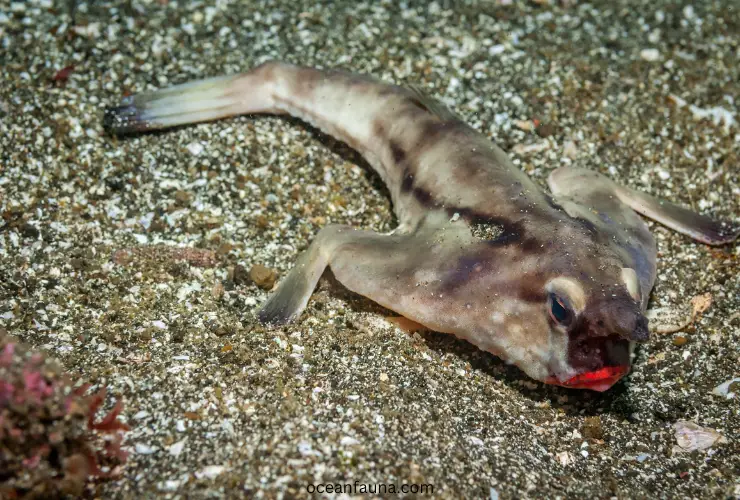
Red-lipped Batfish, scientifically known as Ogcocephalus darwini, are a peculiar species of fish that inhabit the waters surrounding the Galapagos Islands. These fish have a very unique appearance and interesting characteristics that set them apart from other fish species.
One of their most notable features is their red lips, which inspired their common name. These lips are a result of their pigmentation, and they are believed to play a role in attracting prey or mating partners.
Another feature that distinguishes them from other fish is their modified fins, which allow them to “walk” on the sea floor rather than swim.
Despite their inability to swim, Red-lipped Batfish have remarkably adapted to life on the sea floor. They have excellent balance and coordination, allowing them to move around easily, catching prey and avoiding predators.
In addition to their unique movement, they also have a distinctive hunting method. They will lie motionless on the sea floor, blending their fins with their surroundings, and then suddenly strike at their prey.
Spiny Devilfish
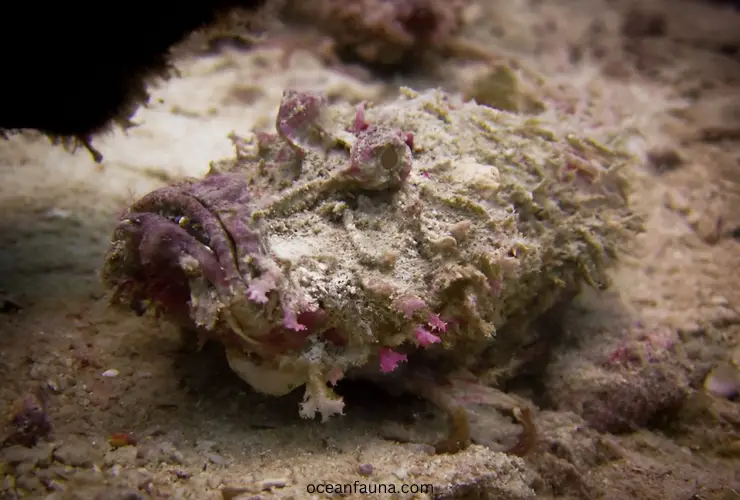
The Spiny Devilfish or Inimicus didactylus, is a fascinating marine creature that belongs to the Synanceiidae family of fishes.
Native to the Indo-West Pacific region, this fish can’t swim and is known for its unique walking method, which it uses to move across the seabed. This method of movement is rather a distinct characteristic of the Spiny Devilfish.
The Spiny Devilfish has many other interesting features besides its walking method. For instance, it has venomous spines lined along its dorsal fin and can sometimes be fatal. The Spiny Devilfish is typically brown or beige in color and has a rough, spiny exterior which aids it in camouflaging itself and blending into its surroundings.
The Spiny devilfish is a carnivorous predator that preys upon small fish, crustaceans, and even other invertebrates. It is an ambush predator and uses its camouflage skills to wait for prey to come within range before striking swiftly.
Interestingly, the Spiny Devilfish may also use its walking method to hunt for prey. It moves slowly and stealthily, using its strong pectoral fins to push itself off the sea bed and walk towards its prey, surprising the unsuspecting victim.
Crabs
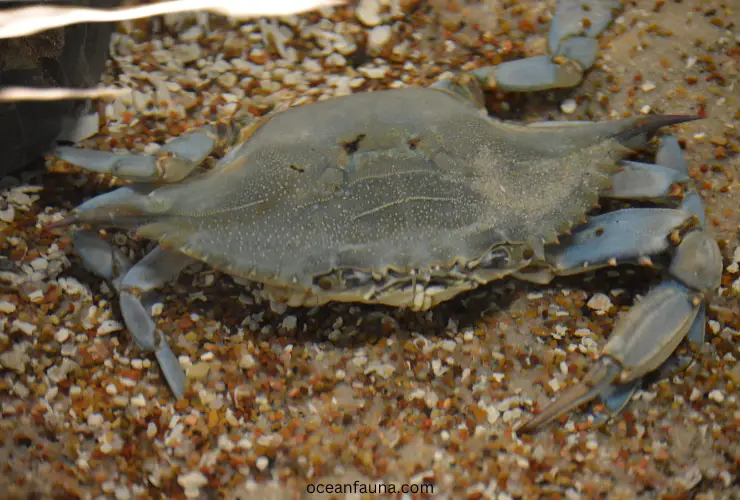
Crabs are fascinating creatures that belong to the order Decapoda, which means “ten-footed.” They have a hard exoskeleton that protects their body and claws, and they walk or run using their eight legs. While a few crab species can swim, most of them prefer to walk or crawl along the bottom of the ocean floor.
Two of the most common crab species that cannot swim are stone crabs and spider crabs.
Stone crabs are usually found in shallow waters and are identified by their large and powerful claws. They use their claws to defend themselves and to capture prey, such as clams and other mollusks. Stone crabs are excellent at camouflaging with their surroundings to avoid predators.
Spider crabs, on the other hand, have long and spindly legs, which give them the appearance of a spider. They are often found in deeper waters. In the case of food, they are scavengers and feed on dead plants, animals, small fish, and crustaceans.
Despite their inability to swim, stone crabs and spider crabs are well adapted to their environment. They have evolved to walk or run across the ocean floor using their legs, and their exoskeletons provide excellent protection against predators.
In addition, these crabs have adapted to their diet and can find and consume abundant food sources in their environment.
Sea Star
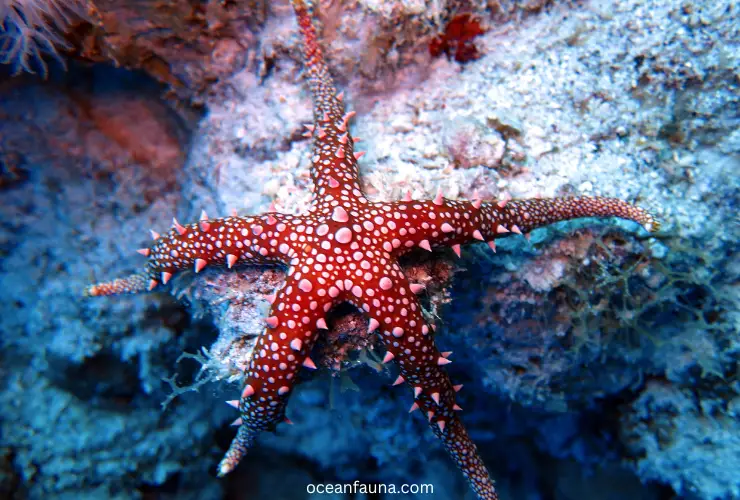
The sea star (Asteroidea) is an amazing marine creature commonly found in various ocean habitats worldwide. These fascinating animals have a unique appearance, with five or more arms protruding from a central disk-shaped body. Their arms are covered in small, sensitive tube feet, which they use for movement, feeding, and gripping onto surfaces.
Although sea stars are not strong swimmers, they are incredibly skilled crawlers and climbers. They use their tube feet to move along the seabed, often traveling for food or shelter. Sea stars can also climb up vertical surfaces, such as the sides of rocks or the strands of seaweed, and even navigate through the complex mazes of coral reefs.
They are opportunistic predators, feeding on various small marine organisms, including mollusks, crustaceans, and even fish. Sea stars use their tube feet to open their prey’s shell and then insert their stomach inside it, digesting the prey from within.
Sea stars are also incredibly durable creatures that survive in harsh environments. Some species can tolerate extreme temperatures and salinity levels, while others can regenerate lost limbs or entire bodies. These adaptations make them formidable survivors in the ever-changing ocean environment.
Sea Lily
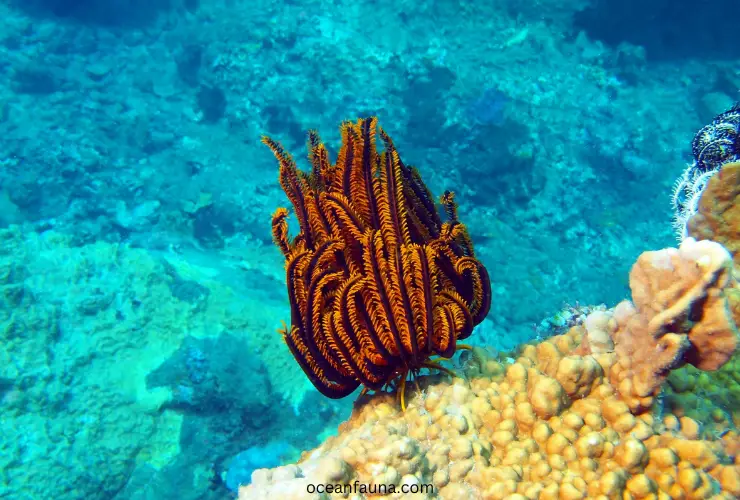
Sea lilies, or Crinoidea, are marine animals belonging to the phylum Echinodermata. They are very interesting creatures that live in oceans worldwide and are known for their unique appearance and behavior.
Unlike other echinoderms, such as starfish and sea urchins that crawl along the seabed, sea lilies attach themselves to the seabed with long stalks and extend their feather-like arms into the water to capture planktonic food.
Sea lilies have been around for millions of years, and fossil records show they were once far more diverse and abundant than they are today. Around 600 species of sea lilies are known to science, but only a few are found in modern-day oceans.
Generally, sea lilies are found in deep waters but can occasionally be seen on rocky shores during low tide. Their stalks can grow up to several meters long, and their arms can reach up to 80 cm in length.
An interesting fact about sea lilies is their feeding behavior. They are filter feeders, which means they use their arms to pump water through their mouths, filtering out tiny organisms such as plankton, larvae, and other small animals.
Sea lilies can detect the movement of tiny prey using a combination of sensory cells on their arms and tube feet. They are also able to retract their arms quickly when threatened by predators.
Conclusion
Now, you have a detailed idea of the 5 ocean animals that can’t swim. All of these creatures have adapted to their environments in unique ways, from the powerful claws of stone crabs and spider crabs to the feather-like arms of sea lilies.
They are fascinating animals that deserve more appreciation for their resilience and survival skills. These creatures amaze us with their adaptations and abilities, whether on land or under the ocean.
If you have more queries about this creature, let me know. I will answer them as soon as possible.

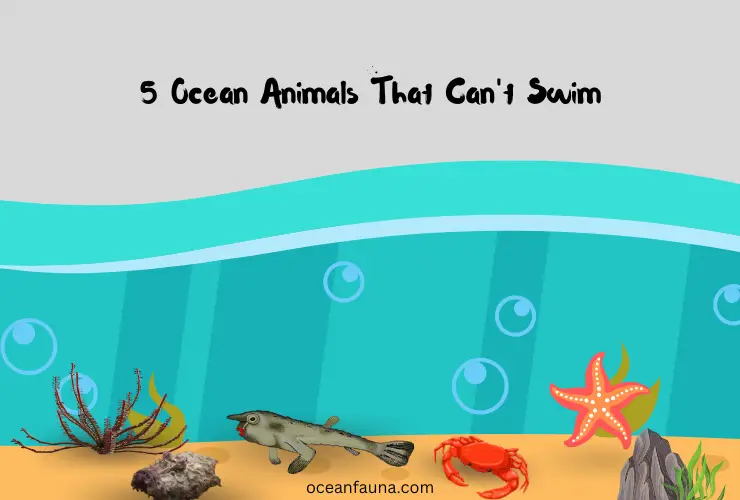
2 thoughts on “5 Ocean Animals That Can’t Swim: Details Explained”